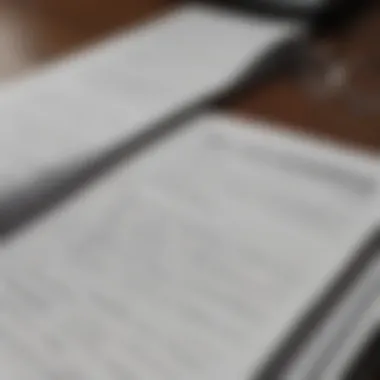How to Determine If You Have Gap Insurance Coverage


Intro
Understanding if you have gap insurance can be vital for individuals investing in a vehicle. Gap insurance serves a nuanced purpose in the realm of auto financing, and it can significantly impact one’s financial situation after a total loss. This is especially relevant for young professionals and families, who may often make high-stakes decisions related to car purchases. It is important not only to know if you have this insurance but also to grasp its implications on your financial health. By delving deep into the ins and outs of gap insurance, this guide seeks to equip readers with the ability to assess their standing clearly and efficiently.
Overview of Insurance and Credit Card Options
Gap insurance is one of many options in the larger ecosystem of insurance products. Understanding its contexts within personal finance is crucial for informed decision-making.
Types of Insurance Products
In the realm of vehicle-related insurance, several products coexist. Each serves specific functions based on individual circumstances. For instance:
- Liability Insurance: Required by law in most places, this covers damages to others in an accident.
- Collision Insurance: This covers damages to your own vehicle following an accident, up to its current market value.
- Comprehensive Insurance: Protects against non-collision incidents (like theft or natural disasters).
Among these, gap insurance steps in when one owes more on a vehicle than it is worth. If the car is totaled, gap insurance covers the difference between the car's value and the amount owed on the loan.
Credit Card Categories
Besides insurance, credit cards also play a role in overall financial health. Various categories exist to match different financial needs:
- Rewards Cards: Offer points or cash back for purchases.
- Travel Cards: Provide benefits for travel-related expenses.
- Secured Credit Cards: Help to build or rebuild credit.
While these credit cards don’t affect whether one has gap insurance, understanding them gear financial strategies aligned with car ownership.
Comparative Analysis
A side-by-side evaluation of insurance options and financial products brings clarity to the choices available.
Comparison of Insurance Plans
Navigating the variety of insurance options can be daunting. Here is a brief comparison:
- Cost: Gap insurance is often more affordable than comprehensive coverage.
- Coverage Scope: Gap insurance only comes into play when a car is financed.
- Accessibility: Some auto lenders include gap insurance automatically; check the loan terms to find out.
Credit Card Comparison
Similar comparisons can be made in the realm of credit cards:
- Annual Fees: Evaluate if the card’s rewards surpass the fee associated.
- Interest Rates: APY is vital; high-interest can lessen benefits gained from rewards.
- Eligibility: Understanding eligibility benchmarks helps avoid credit mishaps.
Expert Insights and Recommendations
Hearing from industry experts provides additional layers of understanding.
Industry Expert Opinions
Professionals advocate assessing your vehicle's depreciation when considering gap insurance. A car loses value quickly, often leaving owners at a disadvantage soon after purchase.
Data-Backed Recommendations
Analysis has shown that cars lose, on average, 20% of their value in the first year. This reality underscores the advantage of having gap insurance, especially for new car buyers. Thorough examination of auto insurance polices can substantiate this need.
Strategies for Financial Decisions
Being strategic aids in making sound financial choices, such as determining whether to integrate gap insurance into your coverage.
How to Choose the Right Insurance
Selecting suitable insurance boils down to:
- Assessing Vehicle Value: Know the current market worth of your vehicle prior to any introduction of insurance.
- Calculator Usage: Online calculators can aid in determining how much coverage is necessary.
Maximizing Credit Card Potential
Achieve maximum benefit from credit cards by:
- Strategic Spending: Use specific cards for different expenses to maximize loyalty rewards.
- Payment Management: Always pay bills on time to avoid interest accumulation and enhance credit scores.
Resources for Additional Learning


Continued financial education enhances awareness and decision-making:
Tools and Calculators
- Websites such as Bankrate provide calculators tailored for vehicle financing.
- Gap insurance evaluators are also accessible online to guide users accurately.
Further Reading and Educational Material
For additional learning on gap insurance and related fields: (insert relevant links)
Understanding whether you have gap insurance unlocks the potential for improved financial stability. Ensuring accurate knowledge allows individuals to align their policies and financial decisions in a manner promoting overall wellbeing.
Understanding Gap Insurance
Gap insurance is a critical component for many vehicle owners, particularly those who have financed their automobile purchase. A thorough understanding of what gap insurance entails can significantly influence financial protection decisions. This segment lays the groundwork for recognizing its character and relevance.
Definition of Gap Insurance
Gap insurance acts as a safeguard for vehicle owners. It aids in covering the difference between the amount owed on a car loan or lease and its current market value, particularly in circumstances of theft or accidents when the vehicle is declared a total loss. Since cars depreciate quickly, there may be a gap between what you owe and what your insurance would payout if your car is totaled. Understanding this definition is foundational for personal finance and responsible vehicle ownership.
Purpose of Gap Insurance
The primary purpose of gap insurance is to shield car owners from unsavory financial burdens following a total loss. Consider a scenario where your vehicle is obliterated in an accident shortly after purchase. Regular auto insurance often only covers its depreciated value, leaving you with outstanding payments. Gap insurance steps in to alleviate this situation.
- It ensures that there will be no financial strain due to negative equity.
- Gap insurance reduces anxiety, knowing that you have a backup disease for expensive gaps created merely by time.
Who Needs Gap Insurance?
Identifying whether you need gap insurance is crucial for prudent financial management. Typically, individuals who may benefit from this coverage include:
- New car buyers: As new cars depreciate the fastest, case scenarios where they find themselves with a higher loan than their car's worth are common.
- Leasing individuals: Many leases have built-in negative equity workshops, enhancing the need for such insurance to mitigate potential losses.
- Drivers with low down payments: A lower down payment can quickly deepen negative equity, where gap insurance can be beneficial.
- Those with high-interest loans: Similarly, high-interest loans tend to exacerbate the possibility of carrying negative equity because of inflated loan totals.
Assessing individual circumstances and the type of vehicle purchased can provide insights into whether gap insurance is the right choice.
Checking Your Insurance Policies
Checking your insurance policies is a crucial step in determining whether you have gap insurance coverage. Understanding your existing auto insurance can help you identify any potential gaps (no pun intended) in your protection. This process is not merely about perusing policy papers; it is more about evaluating your financial standing in relation to your vehicle.
Equipping oneself with sufficient knowledge about one's coverage options can lead to more confident decision-making. In addition, approaching this task can have significant implications on one's overall financial well-being, especially for those who have financed their vehicles.
Reviewing your Auto Insurance Policy
Identifying Coverage Sections
Identifying coverage sections in your auto insurance policy is one of the first actions to take. This part of the examination ensures that you are fully aware of what is included in your insurance. For instance, there are separate sections that outline liabilitycoverage, collision coverage, and comprehensive delinquencies.
The primary purpose of identifying these sections lies in discerning if any provision explicitly states gap coverage. Knowing where to look saves time and minimizes uncertainties. A key characteristic of effective policy checking is being systematic and thorough. When you identify sections correctly, other possible nondisclosures might surface as well—making this a beneficial first step in discovering gap insurance.
Advantageous features are the oft-detailed descriptions of coverage levels within these sections. In a practical sense, if gap insurance isn't explicitly mentioned, it would tell you that you should further investigate.
Key Terms to Look For
Understanding the key terms within your insurance policy is another essential part of the process. Keywords in insurance documents can reveal much informational depth about coverage levels and exclusions. Familiar terms include “total loss coverage,” “adjusted insurance value,” and others relevant to trading vehicles and financing terms.
These specific words are vital in that they tell you about potential protections. Knowing these terms can ease any anxiety during consultations with professionals in the insurance realm. It helps in deciphering complicated provisions, as it lays a foundation for understanding the policy entirely. "Terms to look for create clarity" here. Thorough knowledge equips readers to unite items they may not even realize are valuable.
Hidden complexities may challenge laypersons, and ignorance may obscure key details. This raises an important point for anyone reading policy documents—they should comprehend why searching for key terms is significant.
Contacting Your Insurance Provider
When self-analyzing policies isn't enough, a good approach becomes contacting your insurance providers. Engaging directly with the source might yield more detailed answers, empowering you to explore insurance variances uniquely to your circumstances. This process allows for active participation in building a proper level of financial inventory.
List of Questions to Ask
Having a solid list of pertinent questions is an effective strategy when contacting your provider. Questions should encompass topics such as losses, repayments, and especially if some unforeseen covers exist within your arrangements. Good questions help frame the conversation and are leading toward clearer answers, revealing the specifics of existing gap insurance policies if they do, in fact, exist.
Effectively, if a provider knows you are asking concrete questions, they might allocate extra resources to clarify your inquiries. A list may include, “Do I have gap insurance?” as well as, “What identifies my existing cover circumstances?”
Asking focused questions helps dismantle potential confusion. Slight miscommunications may derail crucial discussions, hence why being prepared counts as significant. The question list thus becomes a point of leverage in these types of discussions.


Understanding Your Representative's Response
The ability to grasp your insurance representative's answers is crucial to maximizing the value of the conversation. Because of potential jargon and detailed provisions, this understanding is not superficial. Paying attention to certain statement structures may directly guide you subsequent actions.
Illustrating effective listening tricks will enhance the level of engagement in dialogues. Perhaps take note of any hesitations or critical caveats during irradiating explanations or unintentionally vague phrases, applying logic behind statements observed as fingerprints of misrepresentation may even indicate additional leakages or exclusions.
Ultimately, actively interpreting responses can chanllege obstacles when uncovering coverage, revealing how close to - or far from persuiging towards gap terms relevant subsiding that next leap.
Attention to detail can transform interactions significantly; where clarity exists confusion departs.
Thorough and investigative conversation paves the way of vetting possibilities.
Effective dialogue suggests entering deep parts of workings not always present in readily available documentation. Knowledge breeds competence and simplicity.
Documentation and Records
Understanding documentation and records is central when checking for gap insurance. These documents serve as vital building blocks in determining the presence and scope of gap insurance. Insurance coverage can vary widely, and detailed examination of these documents can shed light on whether such protection is included in your policy.
While assessing your financial landscape, proper documentation informs decisions. It can safeguard against unexpected losses, ensuring peace of mind. Financiers, like banks or credit unions, may have specific paperwork related to your auto financing with gap coverage clauses. Document diligence protects against misunderstandings in complex agreements. Let's dive into the relevant documents you should gather for this task.
Gathering Relevant Documentation
Insurance Declarations Page
The Insurance Declarations Page provides a summary of your auto insurance coverage. This can be valuable for verifying details about your existing policy. It often outlines coverage limits, deductibles, and other essential facts. Additionally, it highlights whether gap insurance is included or available.
A key characteristic of the declarations page is its clarity. Information is organized succinctly, making it easier to scan for crucial details. Regularly checking this document fosters awareness of your coverage and its stipulations, enhancing your financial literacy.
However, it is important to note some disadvantages. The document only offers a snapshot and may not detail all nuanced exceptions or conditions in your policy. If details seem limited, further inquiry with your insurer is essential. Conveniently, the declarations page comes attached to annual renewal documents, so keeping it accessible ensures you frequently revisit its essential contents, thus supporting informed decisions.
Loan Documents
Loan documents are another essential aspect to review in this analysis, providing contextual information linked to your vehicle's financing. These documents can clarify the terms of your loan and reveal specific options or requirements concerning gap insurance. For anyone bringing their vehicle loan into the equation, understanding these terms is crucial to grasping all insurance options.
One important attribute of loan documents is the ability to check for gap insurance standards set by your lender. Often, lenders may offer gap insurance directly or require it in certain scenarios. Possessing this insight aids in evaluating all possible liabilities while strengthening your financial strategies.
Yet, like any document, loan papers come with some ambiguities. They can be intricate and lengthy, possibly obfuscating straightforward details. Consequently, focusing on sections related to insurance and correctly interpreting them is vital.
Identifying Evidence of Gap Insurance
Facing an implicit uncertainty, recognizing elements of gap insurance in your components of financing might be tricky. Begin by carefully reviewing both the aforementioned documentation aspects with an analytical eye. Pay riches attention to any overlooked sections, contexts, or terms deeply housed within legalese that can substantiate the insurance coverage that pertains to your loan situation.
If you remain uncertain, request clarification from your insurance provider or lender. This proactive approach leads to a precise understanding, forging a path toward coverage that perfectly suits your financial structure.
Assessing Financial Institutions
Assessing financial institutions plays a crucial role in verse where individuals determine if they have gap insurance. As many vehicle financing options involve reputable lenders or financial institutions, the interaction with these providers minimally affects gap insurance presence. It is pivotal to not only recognize your potential coverage but also to understand the finer nuances of loan terms that may include or altogether exclude the option for gap coverage. Therefore, knowing the right questions to ask can make a significant difference in clarity about financial commitments.
Contacting Your Lender
Inquiring About Gap Coverage
When you inquire about gap coverage, you directly engage your lender for detailed information on what your specific policy entails. Understanding whether your financing arrangement includes this opportunity is vital. Often lenders may have predetermined policies regarding gap insurance that can vary widely.
The key characteristic of this inquiry is its effectiveness in providing personalized information about your contract. Knowing you can reach out allows for more tailored understanding of hinted coverages. Additionally, this is a popular choice because it resonates well in direct consumer-lender communications, leading to better-informed decisions.
One unique feature about inquiring directly from your lender refers to their insights into incident-realtive policies. They can afford first-hand details regarding how shifts in vehicle market value influence your loan. Also, they can clarify how adjustments impact both total loss scenarios and potential compensation for vehicles.
Pros:
- Gain access to lender-specific information
- Clarifies contract details and stipulations
Cons:
- May receive biased information depending on lender’s perspective.
Interpreting Responses
Once you have inquired about your gap coverage, interpreting the responses becomes equally important. This aspect centers on understanding the terminology and information the representative provides, which can directly relate to whether you have applied coverage.


The key characteristic here is recognizing the nuances in the answers given. A beneficial approach is listening attentively to details and linking them correctly within the context of your loan agreement. This clarity bolsters transparency regarding financial commitments, making it an essential step in claims visibility.
Ineligibility of answers or vague replies might unfortunately occur. The positive utility of interpreting these responses entails understanding contract limitations and exceptions. Crafting appropriate follow-up questions based on initial responses gives tools for deeper insight into gap policy availability.
Pros:
- Unfold the details hidden in documentation
- Connect directly to contract specifications.
Cons:
- Complexity of terms can make queries ambiguous.
Evaluating Loan Terms
A thorough evaluation of loan terms provides substantial insights into potential gap insurance nuances. It is a step where young professionals, families, and students can perceive if any applicable counseling is present in how the deal evolves vis-a-vis properties like resale value or surrounding market evaluations. Your goal should be to seize knowledge from loan terms, allowing consumers to draw clarifications on their possible vulnerabilities under vehicle financing frameworks.
This recommendation holds immense relevance in understanding how premiums fluctuate or advance based on gaps existing at contract time. Assessing this element can often benefit cost managers positively by sheen light on impending costs concerning insurance volume during various ownership avenues. Divorce coverage inconsistencies may also be noted, which augments overall financial forecasts when deciding on reconnections post-incident. Furthermore, comprehensive comprehension of loan terms can help in strategic future financial considerations as they pertain to auto purchasing agendas.
In summary, understanding your financial institution further paves the way to identifying any gap insurance nuances, while implementing essential responsibilities rests on the consumer continuously assessing different warranties connected to vehicle investments and lending rules.
Exploring Alternative Options
Exploring alternative options for gap insurance can be crucial for understanding your coverage needs. Various solutions exist that offer similar protections. Providers present various policies that can fill the gap between what you owe on a vehicle and its actual cash value in case of a total loss. Assessing these alternatives carefully can save you money and reduce stress.
Considering Standalone Gap Insurance
Standalone gap insurance is a specific type of coverage that is designed solely for bridging the financial gap between your vehicle's outstanding loan balance and its actual cash value in the event of loss.
Benefits of Standalone Policies
Standalone gap insurance often provides distinct advantages. This kind of policy can be beneficial because it typically offers a higher payout. Customers sometimes find premiums lower than those bundled into other insurance products. Another aspect is its flexibility; policyholders may tailor coverage according to their specific situation. Moreover, these policies often come without usage limits or further conditions that can complicate claims.
Cost Comparisons
Cost comparisons are essential when assessing gap insurance options. Different providers have various rates, and the amount of coverage can vary among policies. It is wise to evaluate costs thoroughly. A notable feature when it comes to cost comparisons is the periodic reviews of comprehensive quotes. Understanding upfront fees and ongoing premiums provides greater insight. This measure can also help determine if a particular policy offers considerable savings versus other coverage plans available.
When to Reassess Your Coverage
When to reassess your coverage is as important as obtaining coverage in the first place. Life changes often affect financial circumstances. For example, if you buy a new car, move to a different area, or alter your financing options, you should review your current gap insurance situation. Prices tend to change over time as carriers adjust. Thus, it is valuable to stay informed about both new products and regulated market prices. Factor in changes to both your vehicle’s value and your ability to repay loans as well. Adjustments to your policies ensure that you have reasonable and appropriate coverage that reflects your current need.
Understanding the Importance of Gap Insurance
Understanding the importance of gap insurance is crucial, especially for those who finance or lease their vehicles. This form of insurance acts as a safeguard against the financial burden that can occur when a car is totaled or stolen. The gap between what your insurance payout covers and what you still owe on your car loan can be significant. Knowing this can save individuals from severe financial distress.
Financial Protection in an Accident
When an accident occurs, the initial shock can often lead to confusion about financial responsibilities. If a vehicle is declared a total loss, standard auto insurance typically only covers the market value of the car at the time of the accident. This might not be enough to pay off the remaining balance on a car loan. For many drivers, this scenario means continuing to pay for a vehicle they no longer possess. Gap insurance fills that void, ensuring that any unpaid loan amounts are covered. Hence, the right decision about gap insurance could provide significant peace of mind during troubling times.
Impact on Loan Balances
The presence of gap insurance directly influences one's financial stability when it comes to auto loans. If the vehicle is financed and faces an unfortunate incident, being inadequately insured can result in a negative equity situation. This term refers to when you owe more on a loan than the asset is worth. Gap insurance can prevent this by covering the difference owed on a loan, allowing the owner to move on without the burden of dual payments on a non-existent vehicle. Thus understanding the impact of gap insurance on loan balances is vital; it allows individuals to manage their finances more effectively and with less risk.
Without gap insurance, one accident could lead to long-lasting financial difficulties.
Culmination and Next Steps
In summary, assessing whether you have gap insurance is a critical undertaking for anyone financing a vehicle. Understanding what gap insurance is and its benefits serves as the foundation for making informed choices about automotive coverage. Housing this understanding within a framework enables you to navigate through various documentation and policy inquiries seamlessly. Confirming the presence of gap insurance can provide peace of mind during financial transactions and mitigate potential losses in the event of an accident where the vehicle's trade-in value and remaining loan amounts don't align.
Summarizing Key Points
Several critical points arise in the journey of verifying gap insurance coverage:
- Key Definition: Gap insurance protects against the financial shortfall when an auto loan balance surpasses the vehicle's depreciated value.
- Assess Documentation: Look closely at your autot insurance policy, declarations page, and lender communication for any indications of gap insurance.
- Contact Insurance Providers: Engaging with your insurer offers necessary clarity about existing coverage, which reinforces awareness and proactive management of your financial investments.
- Consider Future Needs: Keeping abreast of your financial landscape ensures that if changes arise in your vehicle status or financing arrangements, your coverage aligns accordingly.
Taking Action
There's more than just reflective knowledge one discovers through this inquiry. Taking active steps to ensure proper coverage is essential to achieving your financial goals related to vehicular ownership and finance.
Follow Up With Providers
Following up with providers is crucial as it ties directly into managing your financial responsibilities. Being proactive in this area typically strengthens relationships with your insurance company and can lead to more tailored services or discounts. The primary characteristic here is communication. By establishing dialogue, you can ask specific questions, which could unearth opportunities or unrecognized options. The unique benefit is often the rediscovery of potential savings or additional coverage pathways, enhancing what you know about your current policy. Consider discussing gaps or confirmatory coverage extensions when inquiries are made.
Evaluate Future Coverage Needs
As personal financial situations evolve, reevaluating coverage needs ensures you are not left at risk later. Changes like purchasing a new vehicle or shifting financial responsibilities make prior coverage potentially inadequate. The key aspect here is adaptivity. This proactive approach assures that your coverage evolves along with significant personal circumstances. Furthermore, recognizing how recent vehicle valuation trends might impact your obligations allows you to target poor allocation to newer investments. Continuously revisiting your policy arrangements can amplify the protection needed according to future vehicular configurations and liabilities.
Keeping track of your coverage status and proactively switching as life circumstances alter fortifies financial security during uncertain times.







